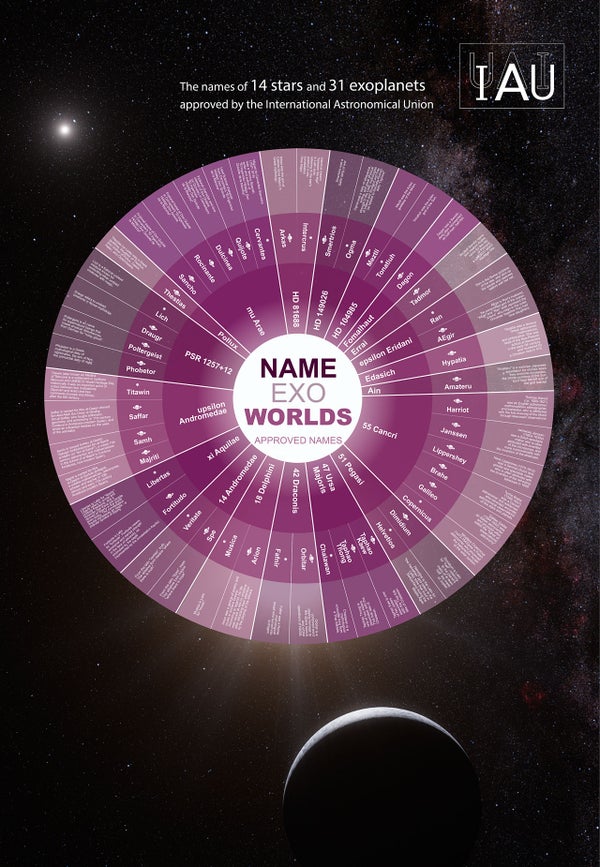This article was published in Scientific American’s former blog network and reflects the views of the author, not necessarily those of Scientific American
The votes are in. The International Astronomical Union (IAU), a collective of astronomers with the authority to give titles to celestial bodies, has assigned crowdsourced names to several prominent exoplanetary systems.
The IAU’s NameExoWorlds contest, which began in July 2014, consisted of public and semi-private rounds of submissions and voting on names for 32 exoplanets and 15 host stars. This past August, I reported on the process, which wasn’t entirely smooth. The IAU’s list of 274 proposed names included goofy, questionable candidates like “Ninja,” “Rock’n’Roll Star” and “Starry Bunnies,” and exuberant Japanese astronomy clubs flooded early polling, stacking the deck in favor of most worlds becoming the namesakes of Japanese pro wrestlers, soybean varieties, board games and desserts.
Thankfully, the names announced today aren’t anything to be embarrassed about, and show a decent balance of international representation. And they won’t really replace anything—the new names will be used in conjunction with the old from existing scientific nomenclature, which, with titles like “Epsilon Eridani b” and “MOA-2007-BLG-192Lb,” possess an abstract, algorithmic poetry all their own.
On supporting science journalism
If you're enjoying this article, consider supporting our award-winning journalism by subscribing. By purchasing a subscription you are helping to ensure the future of impactful stories about the discoveries and ideas shaping our world today.
Based on more than half a million votes from people in 182 countries, Europe and Asia both lead with six winning entries each, while four of the systems names come from North America. Latin America, the Middle East and Africa round out the names with one winning entry apiece. Only one of the candidate systems, the star Tau Boötis and its planet Tau Boötis b, did not receive a name, because, the IAU cryptically says, its winning entry “was judged not to conform with the IAU rules for naming exoplanets.”
The very first confirmed exoplanetary system, announced in 1992, consists of three rocky worlds orbiting a stellar remnant, a millisecond pulsar ignominiously named PSR 1257+12. Now, the pulsar is suitably called “Lich,” a name for an undead wizard from Greek, Dutch, and Norse folktales. Its three planets bear similarly spooky names drawn from ghostly mythological creatures—“Poltergeist,” “Phobetor” and “Draugr.”
Pegasi 51, the first normal star found to host exoplanets, now has a more mellifluous name: “Helvetios,” a Latinized reference to the Helvetians, a tribe of Celts that lived in the Swiss Alps. The name nods to the Swiss astronomers Michel Mayor and Didier Queloz, who discovered the star’s giant planet, Pegasi 51 b, in 1995. Now, that planet is officially dubbed “Dimidium,” Latin for “the half,” a reference to its mass, which is half of Jupiter’s.
Other systems have gained the names of notable figures from history or literature. As proposed by a group in the Netherlands, the star 55 Cancri will now be called “Copernicus,” and its planets will be called “Galileo,” “Brahe,” “Lippershey,” “Janssen,” and “Harriot.” And Spain succeeded in exporting one of its great authors to the heavens—the star Mu Arae is now also known as “Cervantes,” and is accompanied by planets named for his masterwork Don Quixote—“Dulcinea,” “Rocinante,” and, of course, “Quijote” and “Sancho.”
That said, there are still a couple of bemusing choices among the selected names. The giant planet circling 42 Draconis (excuse me, circling “Fafnir”) will henceforth be called “Orbitar”—a name perhaps more suitable for a supervillain in a Saturday-morning cartoon than for a planet. And the planet-bearing star HD 81688 may now be better known as “Intercrus.” This is not, it turns out, a slang term for sexual intimacy on a boat or with the star of Top Gun, but rather a “Latin style” word meaning “between the legs,” since the system suggestively sits like a ball of scat below the nether regions of Ursa Major, a constellation resembling a she-bear.
As to whether all this actually means anything, well… Maybe indulging our urge to name might help us strive to know more about these distant planets, to learn whether the titles we give them ring true. It’s possible that someday, a long time from now, we shall run out of words for all the worlds we find. More than 2,000 are already known, and a new generation of planet-hunting projects is set to deliver tens of thousands more in coming years. Even this is the barest fraction of the hundreds of billions of worlds thought to exist in our galaxy alone. All our Earthly labels aside, the reality is that planets in the cosmos are as unnamable as they are innumerable—and that’s a good thing.
